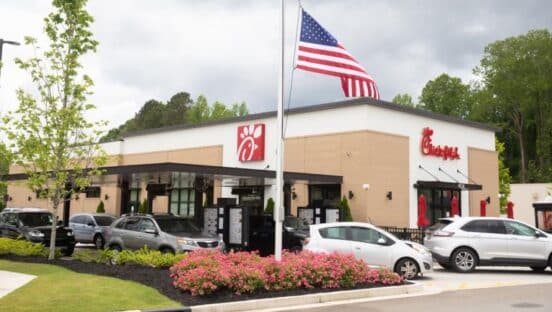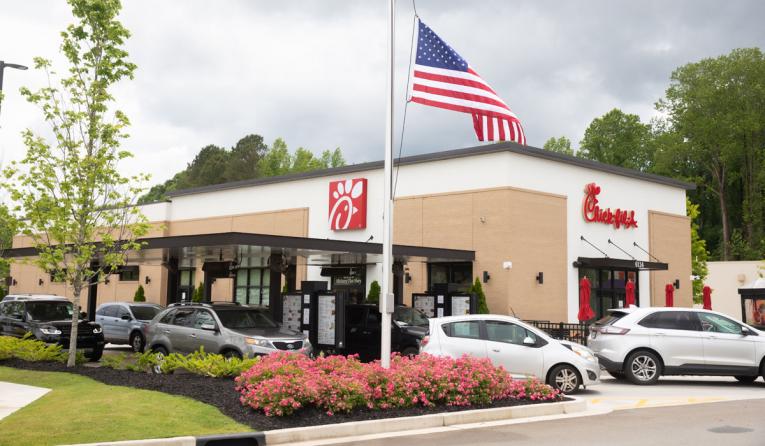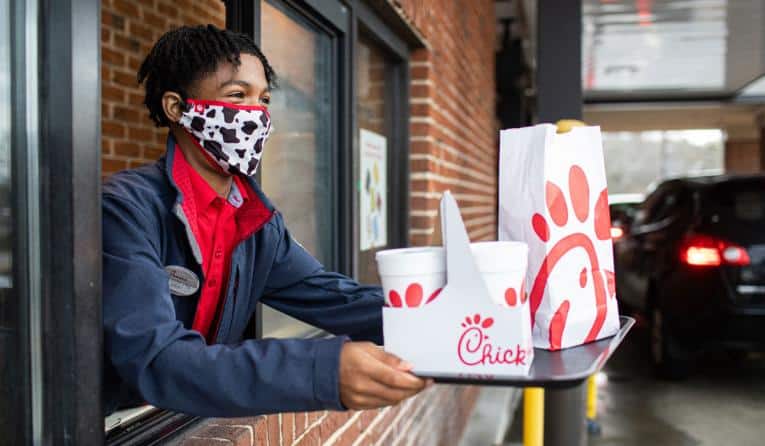
Chick-fil-A designed a check-point system where customers could be greeted and served hospitality at multiple stops, from order taking to payment to meal delivery.
Guests seek an experience that’s fast and accurate, Cooper says, and they don’t want to feel rushed. “And so being able to have that balance is key,” she says.
Truth is, perception of speed and clocked speed are not the same given the tools at hand, and COVID proved that as much as anything ever did. Chick-fil-A found ways to continue to connect employees to guests in the line, which is something it did pre-virus, too, when the brand employed “face-to-face ordering” about 60 percent of the time.
Not surprisingly, this became far more common over the past year as brands aim to recreate the missing in-store experience outside. Starbucks is investing in the model and Taco Bell planned to have 1,000 “bellhops” roaming lines by summer’s end. “That’s where that commitment to hospitality returns as well,” Cooper says. “For you to be greeted by a friendly team member who is smiling underneath that mask, that is able to quickly capture that order and make sure that you have everything you need.”
Chick-fil-A fronted the field for order accuracy in QSR magazine’s Drive-Thru Study at 100 percent. It’s no mean feat, as half of consumers in the study said they experienced some sort of mistake in their to-go order.
CHECK OUT THE FULL ORDER ACCURACY CHART
From the consumer study portion of the QSR magazine Drive-Thru Study, 89 percent of respondents said order accuracy was “somewhat” or “most” important to them with their experience. Speed of service trailed just behind at 88 percent. Both climbed from 2020 figures of 87 and 84 percent, respectively, which hints higher standards emerged from increased usage. But the No. 1 reason for a drive-thru visit was “convenience,” at 75 percent, not speed (45 percent), which bears another question: Is convenience a term we need to examine through multiple filters? Spun differently, is getting an order wrong as inconvenient as being asked to wait longer?
And can customer service and technology, like mobile ordering and order confirmation screens, adjust the overall perception?
CHECK OUT THE FULL CUSTOMER SERVICE CHART
Chick-fil-A sure believes so, and it’s a multi-layered effort, from order point to payment to pickup that stretches the traditional in-restaurant experience across the drive-thru channel. It was essential to ensure the broken-up path seemed connected, Cooper says, so guests didn’t feel like they were starting over every time they engaged with a new Chick-fil-A employee.
“So making sure that we use the guest’s name and they receive the order that belongs to them and they felt confident that it’s the correct order,” she says. “And then making sure they have a fond farewell.”
Close to 30 percent (27) of respondents in QSR magazine’s Drive-Thru Study noted they preferred separate payment and pickup windows instead of a single window for both. Eighteen percent were “completely” on board. Additionally, those numbers were 26 and 15 percent, respectively, regarding the question of whether customers disliked being asked to move to a separate waiting area when they approached the pickup window after their order was not ready. Mostly (24 percent), guests seemed indifferent to this point. Yet Gen Z consumers pulsed as more likely to become frustrated, suggesting this generation might be more impatient and often on-the-go.
Regardless, though, as Cooper says, there’s value in streamlining drive-thru flow so it feels deliberate and constantly moving.
Bringing hospitality outside, especially on the meal fulfillment side, allowed Chick-fil-A the power to constantly work upstream. Guests have an interaction moment sooner than getting to a static point (menuboard) where they’d typically have to wait for people in front of them to order. Again, watching a line move and not stall, even as you pass by from the main road, is a crucial element of that overall speed battle, Cooper says.

Trust is the key, says Chick-fil-A’s Khalilah Cooper.
According to QSR magazine’s Drive-Thru Study, more consumers in 2021 were open to placing drive-thru orders with an employee walking alongside their car (like Chick-fil-A) versus through a speaker/pay window. Thirty-five percent of respondents agreed or completely agreed with the notion. That was 28 percent last year.
“I think the speed component of that drive-thru experience is also mitigated by the amount of control that customers have in their experience,” Cooper says. “And so that’s where the mobile app comes into play.” Like many chains, Chick-fil-A saw its app and digital ordering skyrocket during COVID as guests connected experiences across channels. It gave customers options to flex order points—on-site or before they show up—and also the ability to consider other options, such as curbside, which spread almost immediately from about a third of Chick-fil-A units before coronavirus to roughly three quarters.
A full 45 percent of QSR magazine Drive-Thru Study respondents said they wished there were more mobile ordering options available for drive-thru orders. With Gen Z, preference surged to 65 percent in 2021 versus 41 percent the year before.
Carryout and delivery gained steam for Chick-fil-A as the brand worked to turn its parking lots into massive transaction centers. Operators created curbside spots with tools they could get at hardware stores. And Chick-fil-A uploaded signage on its intranet for franchisees to print out and put into action. Stores propped up canopies and added lanes. Mall units turned outdoor spaces into makeshift drive-thrus.
Overall, there were a lot of factors determining drive-thru success in 2020 that varied by brand and approach. In Chick-fil-A’s case, speed was an ecosystem statistic and also the reflection of the fact it was busy far more often than it wasn’t.
You simply have to take into account that reality, which backs the anecdotal remarks seen on social media last year. Chick-fil-A had more cars lined up than anybody else—nearly twice the number of its nearest competitor in McDonald’s.
CHECK OUT THE VEHICLES IN LINE CHART
Chick-fil-A’s setup measures quite differently from traditional models as well, where guests order at the speaker box. When does the clock really begin? And is that the question everybody should be asking?
The answers is, it depends.
Finding out what mattered most to customers during the pandemic was the great drive-thru separator.
At Taco Bell, the Yum! Brands chain posted its sixth consecutive quarter of sub-4-minute drive-thru order to delivery times in Q2. It was 6 seconds faster year-over-year as the brand served 4 million more cars compared to the same period in 2020. This despite obvious surges in off-premises demand.
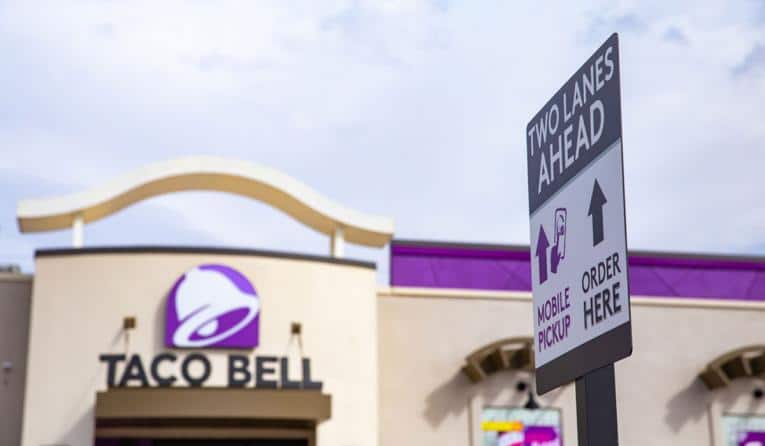
When the time to pivot away from dine-in arrived, president and global COO Mike Grams says, Taco Bell recognized the need to examine drive-thru performance and identify ways to optimize experience. “From a consumer perspective, our primary goal was to make their drive-thru experience quick, efficient, and meet their needs,” he says. “For our team members, we wanted to ease the experience so the drive-thru would continue to move even during peak hours.”
Taco Bell added contactless payment and “speed lines,” which are additional production lines in the back. It also implemented new kitchen display systems to make it easier for employees to build and serve food. Taco Bell tweaked labor so more workers would be on the clock when business picked up.
But arguably the most noticeable shift is unfolding with Taco Bell’s Go Mobile design. And this might be the most dramatic after-shock of COVID at the drive-thru—the reimagining of what quick-service restaurants even look like on the other side.
Taco Bell’s model features a dual drive-thru with a priority pickup lane and rapid service for guests who order through Taco Bell’s app. Akin to Chick-fil-A, ordering in drive-thrus and curbside pickup will be operated by a concierge service of employees Taco Bell dubbed “bellhops.”
Grams says Taco Bell expedited the launch of its 1,325-square-foot Go Mobile store (typical Taco Bells are roughly 2,500 square feet) in light of the crisis. Expect to see an evolved physical footprint with synchronized digital experiences that streamline access points and cater to a new era of convenience (lanes for digital and curbside-dedicated assets). One feature also being “smart kitchen” technology that integrates with Taco Bell’s app and can detect when guests arrive and suggest the quickest route.
“As we continue our restaurant development plans, these industry-leading features will continue to be a part of our holistic Taco Bell restaurant experience,” Grams says. “Not only are these features continuing to be implemented, but we’re also expanding them in areas where they meet the needs of the community it serves.”
This past year, Taco Bell introduced a “Cantina” with a drive-thru lane in Danville, California—the first of its kind. As with most Taco Bell Cantina stores, it has a full bar, as well as an outdoor space with a fire pit and corn hole.
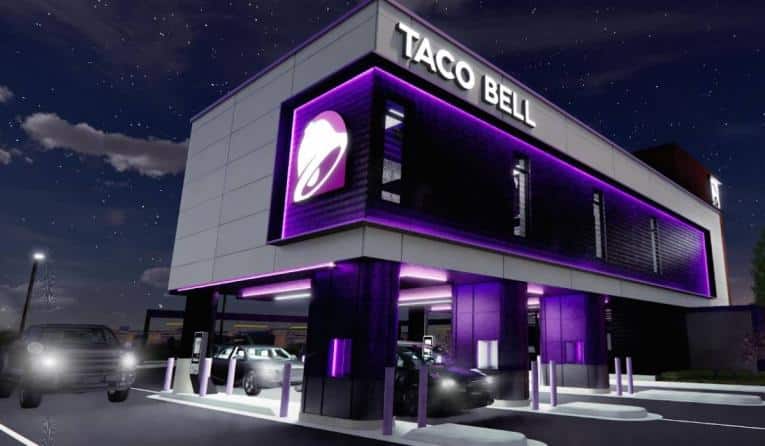
In mid-August, Taco Bell took its ambition up another notch with the “Defy” prototype. It’s a futuristic, two-story model that features four drive-thru lanes, including one traditional path and three others dedicated to mobile or delivery order pickups. There’s also digital check-in screens that allow mobile order consumers to scan their order via QR codes and grab food through a contactless “bell-evator” lift system. During ordering, two-way audio and video technology will enable customers to interact with employees located on the second story.
Set to be run by 35-year franchisee Border Foods and developed in partnership with Minneapolis-based Vertical Works, the innovative restaurant was scheduled to break ground in Brooklyn Park, Minnesota, late August and open by summer 2022. “What we learn from the test of this new Defy concept may help shape future Taco Bell restaurants,” Grams says.
Yum! sister brand KFC lifted the lid on its “Next Generation” prototype in 2020 as well, a venue that boasts a double drive-thru lane. The brand’s U.S. drive-thru sales hiked 50 percent in Q1 2021 compared to the previous year, with drive-thru sales accounting for roughly 80 percent of total business. This flow of transactions led KFC to many of the prototype’s design elements, including curbside delivery, parking for aggregators, and self-service kiosks inside stores. Also, a pickup shelf for mobile and delivery orders in an effort to remove contact between employees and guests as orders go from the kitchen to the cubbies. An urban concept prototype will be half the size of standard units, have limited or no dine-in capacity, and be fully dedicated to drive-thru, delivery, and contactless pickup orders.
In current restaurants, KFC devised a way for guests to avoid the drive-thru altogether with the option to order ahead for pickup and receive an alert when food is ready, creating a connected approach and alleviating drive-thru traffic, a brand spokesperson said.
Clearly, the drive-thru isn’t a one-dimensional trade-off any longer for consumers—the age-old idea of swapping convenience for quality (or experience). There are too many options available and strides underway. In turn, guest expectations are getting reset.

In May 2021, 70 percent of respondents in location company Bluedot’s “State of What Feeds Us” report said they visited the drive-thru the same or more often than before. In August 2020, it was 74 percent. So guests weren’t abandoning drive-thru even with restrictions loosening.
Going back to last July, when restaurants started to reopen, drive-thru visits still increased by 13 percent, NPD said—the highest visit lift among the service modes of on-premises, carryout, and delivery.
When Bluedot asked consumers what their No. 1 want from the “restaurant of the future” was, a “designated drive-thru lane for mobile pickup” topped the list. Thirty-one percent of respondents said the feature would keep them coming back.
This surfaced in QSR magazine’s Drive-Thru Study as well, with roughly half of respondents saying they’d be interested in preordering and using a designated lane solely for pickup.
Customers also highlighted automated car detection and ordering from the car as the most desired methods for future drive-thru ordering. Thirty-five percent picked “automated technology detects car arrival for pickup order,” while carhops (place order from car) and a pre-paid, pickup experience each received 34 percent.
In this go-forward look, however, were also traditional hallmarks of the drive-thru. Forty percent of diners in Bluedot’s study ranked a digital menuboard to confirm their order as one of the top reasons they would revisit. One in three wanted personalized deals. Twenty-four percent requested a smart menuboard that greets them by name and knows their regular order.
“A menuboard placed ahead of ordering speaker so there is more time to review prior to order,” was only behind order accuracy and speed of service as a top drive-thru visit factor in QSR magazine’s Drive-Thru Study (80 percent). Order confirmation screens chimed in at 74 percent.
This latter feature, which assists in validating food orders, proved more important to millennial and Boomer generations, at 75 percent.
CKE Restaurant Holdings (Carl’s Jr. and Hardee’s) chief global development officer Matthew Walls, a former Domino’s executive who joined the company in June, says consumers dictated the “dramatic shift” restaurants had to make. Quick-serves at the drive-thru had a lot to live up to inspire repeat business.
“As the queues started to get longer and longer and, actually, those queues weren’t just in typical dayparts, they were throughout the day, it did make us focus in on what are the processes and the technology and even the people management aspects of our business that had to change; had to evolve,” Walls says.
In a world before coronavirus, CKE had static menuboards, single-lane drive-thrus, and no curbside. What Carl’s Jr. and Hardee’s realized, Walls says, is it would lose business simply due to how long lines had become. People could drive somewhere else.
It led CKE down a multi-pronged path, as Chick-fil-A, KFC, and Taco Bell brought up. If guests didn’t want drive-thru, make sure they had curbside as an alternative. Offer them delivery.
“It wasn’t just drive-thru. It was this omnichannel experience that drove us through COVID,” Walls says. “We believe it’s actually the future of our brand.”
CKE took the COVID opportunity to enhance its drive-thru window technology. Phil Crawford, the company’s chief technical officer and a former Shake Shack leader, helped build digital menuboards that have started to roll across the fleet.
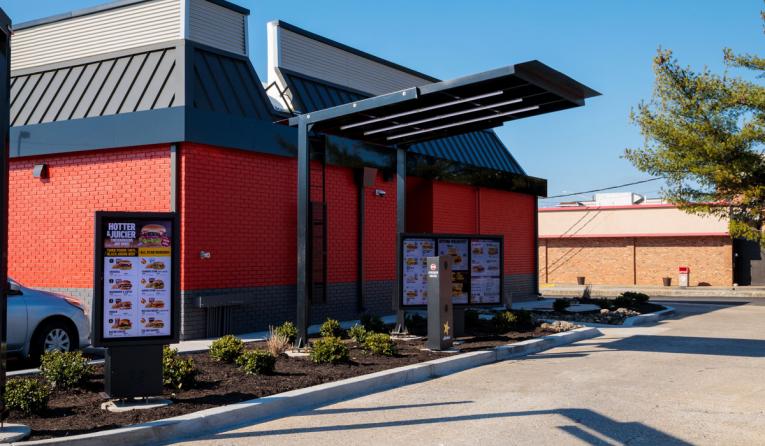
“Part of the reason customers always felt like they had to yell into the speaker box, was because technology in a lot of drive-thrus is just poor,” Walls says. “And words are missed. And you know, when you don’t want ketchup on your burger and you’re not sure if the person heard you or not, that’s a tense moment.”
It’s an industry-wide inflection.
CHECK OUT THE FULL DIGITAL MENUBOARDS CHART
Younger consumers in QSR magazine’s Drive-Thru Study favored digital menus, saying they were easier to read due to the general display, text size, and lighting. Twenty-seven percent of respondents agreed they prefer the feature, while 16 percent agreed completely.
Also, 46 percent of consumers indicated they would like additional signage to help make their decisions.
In another data point, roughly two-fifths of consumers disliked hearing an automated voice when visiting the drive-thru, indicating guests want a more personal experience.
CKE’s new reader confirmation boards aim to strip anxiety out. To the menu point, they present all of CKE’s offerings and create upselling components. Walls says CKE’s tech isn’t just static menuboards turned digital, either. They boast the option to layer in innovation down the line, like AI to curate that personalization people clamor for.
“The customer experience continues to evolve,” Walls says. “We’re all customers, and we all want the same thing, which is as little friction as possible in the transaction process.”
Per the QSR magazine Drive-Thru Study, slightly less than half of brands tested had integrated suggestive selling into their ordering process, with the largest share doing so during greeting (28 percent).
CHECK OUT THE SUGGESTIVE SELL CHART
Count CKE among the brands working on a future prototype. It’s moving toward smaller dining rooms and more space for things like extra drive-thru lanes, designated curbside pickup parking, and easily accessible delivery windows for third-party drivers.
One design, likely for urban areas, offers guests a chance to walk up and grab food out of a locker. “These omnichannel stores, they take all of these service methods into one footprint that allows a very wide cross section of customers to interact with us in the way they want to,” Walls says. “And I think that’s the real key here—is that traditionally retail and [quick service] has always been about here’s how we will react to the customer and hopefully they’re accommodating to that. And today’s customer, they’re expected to have their service needs met the way that they want to.”
These futuristic prototypes are popping up in every corner of quick service. Many skirt the dining room altogether in favor of a drive-thru-centric design. It crosses segments, too, with fast casuals like Shake Shack concepting triple-lane drive-thrus to Sweetgreen plotting entry into the space.
Wendy’s is working on a drive-thru only store of its own, as well as modular concepts, says U.S COO Deepak Ajmani. Carryout, delivery, and curbside will be part of those restaurants. “We’re stretching our creativity in new restaurant design and development to rethink the physical space,” he says. “We’re looking to scale up, evolve our new restaurants, and innovate non-traditional concepts that will unleash growth.”
Ajmani has worked in restaurants for more than 30 years, starting as an assistant manager in training. He’s been around long enough to clock time alongside Wendy’s founder Dave Thomas. And 2020 was as eye-opening as any stretch.
“This past year showed us that the drive thru is as important as ever—something Wendy’s started back in 1970 when we created the very first modern-day pickup window—and it’s one of the reasons why the [quick-service] category fared better than dine-in only concepts during the pandemic.”
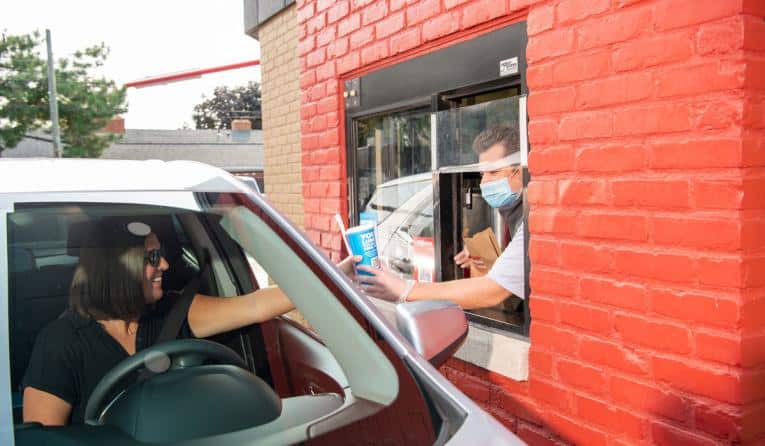
In that, Ajmani adds, came a renewed focus on throughput, efficiency, accuracy, and friendliness—all similar threads throughout the brands featured in this study. “Previously, customers had two ways to get Wendy’s food—dine-in and the pickup window—but the pandemic really accelerated our digital offerings,” he says. “We now have more channels available to get our food with curbside, mobile and grab-and-go. And with the rise of family-size meals and delivery orders during the pandemic, these additional options helped alleviate the stress placed on the drive-thru line.”
Wendy’s said in Q1 that 90 percent of customers coming to its restaurants pulled into the drive-thru. And you now also have to factor in breakfast, which ballooned to a billion-dollar business for Wendy’s. The daypart expansion arrived in March 2020 on the doorstep of coronavirus. It was always designed as a drive-thru-specific effort to help Wendy’s navigate labor challenges and ensure complexity wouldn’t get in the way of profitability.
Ajmani says Wendy’s speed of service improved year-over-year in Q1 and has held steady. “Which, when you put it into the context of items per transaction being up over 10 percent, it’s something we’re very proud of,” he says.
While new tech and COVID-inspired changes are very real elements of this, as the upcoming prototype proves, Ajmani says drive-thru success in 2020 was rooted in fundamentals. “One of my favorite sayings is, ‘it’s not real until it’s real in our restaurants,’” he notes.
However, Wendy’s did introduce fresh ideas, like additional training tools for employees. It started recognizing district and general managers at the system level for their speed of service improvements. Wendy’s spotlighted franchise groups investing in people and facilities to support throughput and efficiency, and encouraged restaurants to have fun and stay energized. For example, Wendy’s hosted a national competition to find the fastest district manager in the system and recognized other division winners for speed of service accomplishments.
Guest behavior continues to lead this discussion. More family-size meal orders and delivery flooded in during COVID, which bottlenecked drive-thru speed for Wendy’s. In response, the brand stood up curbside, mobile, and grab-and-go to help move these orders out of the drive-thru line “into an option just as easy and fast,” Ajmani says. As of March, Wendy’s had 2,000-plus sites live with curbside.
Sound familiar?
“In the end, it all comes down to quality food, positive customer experiences, a great team and, of course, fast food done right,” he says. “If we can deliver on those things, we’re doing it right. In the 30 years that I’ve been with the brand, I’ve never been more excited about our future.
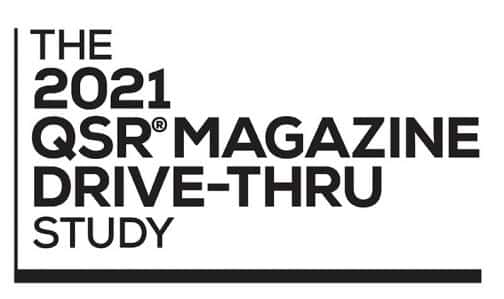
In late January, a drive-thru clinic opened in the suburban town of Mount Pleasant, South Carolina. Local hospitals hoped to administer early shots of the COVID-19 vaccine, but soon after, the computer system malfunctioned, leaving hundreds of people idling in their cars for hours.
Word got back to Mount Pleasant Mayor Will Haynie. His response? Pick up the phone and call the manager of a local fast-food restaurant.
It was no great mystery at this point that quick-service chains had retrenched their expertise in one of the country’s true mainstays. Drive-thru restaurant visits increased 26 percent in the April, May, and June quarter of 2020 and represented 42 percent of all traffic, according to The NPD Group. By December, drive-thru lanes mixed 44 percent of off-premises orders industry-wide. As much buzz as virtual brands, delivery, curbside, and other upstart outlets received last year, it was the classic that stood tallest. Although this was hardly your parents’ drive-thru. Contactless tech, artificial intelligence, multiple lane setups—all sprung up in the wake of COVID’s disruption. While many fast-food chains welcomed 70 percent of sales via drive-thru before coronavirus, the number jolted well above 90 percent overnight. The effort to survive pandemic conditions fast became a crash course in operations. Speed of service. Hospitality. Employee and guest safety. The quick-service industry’s greatest differentiator had to be its best one, too. After all, it might be the only person-to-person interaction somebody had that entire day in lockdown conditions. And it might be the only job available for industry workers hoping to navigate economic uncertainty.
What also shouldn’t surprise anybody is who Mayor Haynie called. He dialed up Jerry Walkowiak, the manager of a nearby Chick-fil-A. Walkowiak looked things over and made a quick assessment. The pop-up clinic had only one person checking arrivals in.
Walkowiak gathered volunteers and reduced the wait to 15 minutes. More than 1,000 people received the COVID vaccine that day. Haynie asked Walkowiak to return in February for the second round of shots.
Khalilah Cooper, Chick-fil-A’s senior director of service and hospitality, heard similar stories throughout the past 18 months, ever since the brand shut its dining rooms in mid-March 2020. The ability for Chick-fil-A to convey its strengths, especially concerning hospitality, became paramount.
“We focused on safe service first,” she says, “and then that service excellence piece and our commitment to hospitality has been unwavering.”
There were headline grabbers like Walkowiak’s example, but also small efforts such as employees writing notes on customers’ bags. A store in Tucson, Arizona, created an outdoor handwashing station that other units soon adopted. Chick-fil-A used bins to collect cash, and deployed mobile credit card readers for employees walking the line to accept contactless payment.
One of the most noticeable efforts, though, was Chick-fil-A’s near-mythical ability to usher through endless lines of cars.
As people on social media professed, Chick-fil-A’s long lines hardly dissuaded the masses.
The reason speaks to something broader that flashed during COVID, and illustrates how the definition of “speed of service” isn’t so cut-and-dry in today’s drive-thru, and likely won’t be moving forward.
“That level of trust,” Cooper says. “I have to trust that this experience is going to be a good one for me to get into this line.”
As the 2021 QSR magazine Drive Thru Study showed, by the numbers, Chick-fil-A was not the speediest chain during COVID. It trailed the pack at 541 seconds. The average was 346 seconds, with Taco Bell leading the charge at 268 seconds.
CHECK OUT THE FULL SPEED OF SERVICE CHART
But you could argue nobody achieved what Cooper suggested better or stood out more, making Chick-fil-A QSR magazine’s Drive-Thru Restaurant of the Year for 2021.

